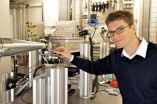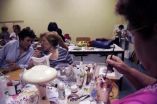(Press-News.org) LA JOLLA, CA – September 20, 2010 –– A team at The Scripps Research Institute has detailed the structure of a member of the only remaining class of multidrug resistance transporters left to be described. The work has implications for combating dangerous antibiotic resistant strains of bacteria, as well as for developing hardy strains of agricultural crops.
The study was published in an advance, online issue of the journal Nature on September 22, 2010.
"Now with our crystal structure, scientists can for the first time figure out exactly how this transporter works," said the study's senior investigator, Geoffrey Chang, Ph.D., associate professor in the Scripps Research Department of Molecular Biology. "This could lead to the design of drugs that evade or inhibit the transporter, or to reengineering the transporter to help some plants grow in soil they can't grow in now."
The protein described in the study, NorM, was found in the virulent bacteria Vibrio cholerae. V. cholerae causes cholera, a disease that affects the small intestine and is a common cause of death in developing nations. The NorM transporter is responsible for widespread resistance to ciprofloxacin and other fluoroquinolones (a broad-spectrum, inexpensive class of antibiotics) and to tigecycline, a new class of drug specifically designed to overcome that antibiotic resistance.
Importantly, NorM is a member of the multidrug and toxic compound extrusion (MATE) family that is involved in important biological functions across all kingdoms of life. These transporters defend plant, animal, and microbial cells by pumping out toxic chemicals before they can have any effect. In addition to antibiotic resistance, MATE transporters are associated with resistance to a commonly used diabetes drug, as well as resistance to anti-inflammatory and anti- arrhythmia agents. In plants, MATE transporters help to neutralize the acidity of soil, directly affecting crop yields worldwide.
"By showing how a key member of the [MATE transporter] family undergoes shape changes during the extrusion process, this work may lead to new ways to block the transporter, with possible applications in medicine and agriculture," said Jean Chin, Ph.D., who oversees this and other structural biology grants at the National Institutes of Health (NIH).
"Herculean Effort"
It took a "Herculean effort" to produce the high-resolution crystal structure of NorM, Chang noted. The researchers found it was difficult to produce enough protein to work with, and hard to purify the transporter in its natural state.
After the team found a way to produce and purify the protein, the scientists still needed to create crystals to be able to use a technique known as x-ray crystallography to solve its structure. In this method, scientists produce and purify large quantities of a protein that are crystallized. The crystal is then placed in front of a beam of x-rays, which diffract when they strike the atoms in the crystal. Based on the pattern of diffraction, scientists can reconstruct the shape of the original molecule. In this case, though, the NorM crystals were unusually fragile under an x-ray beam.
After many attempts, however, the research team succeeded in producing two crystal structures of the NorM transporter as it sat on the outside surface of V. cholerae. One showed the transporter by itself and the other provided a snapshot of how the pump is powered by sodium ions.
The NorM transporter normally sits, waiting, on the inside of the bacterial cell membrane for toxic chemicals—in this case antibiotics—that seep inside. The protein then changes shape in order to scoop the chemical up, and transport it back through the cell wall to the outside of the bacteria, keeping the bacteria safe from destruction.
The structure of this bacterial pump revealed a shape distinct from all other MDR transporter families, say co-authors Xiao He and Paul Szewczyk, graduate students at the University of San Diego, California, (UCSD) who worked with Chang to derive the structure. The pair also took the lead in the effort to verify the crystal structure – a process of labeling 16 different amino acids on the protein and confirming their three-dimensional position. This part of the effort took 18 months.
On the outside of the bacteria, the transporter looks like an upside down "V" shaped lampshade, He said, and the chemical to be removed presumably fits inside the narrow part of the structure. She adds that the research team is working to crystallize the transporter on the inside of the bacterium, as well as the structure with a chemical bound to it.
"Bacteria have a number of different transporter systems, so it is important to design antibiotics that will not be instantly pumped out," He noted.
With the atomic structure of NorM solved, the team continues to investigate other MATE transporters, including those found in plants and those that exist in human liver and kidney cells that can reduce the effectiveness of a wide variety of drugs.
###
In addition to Chang, He, and Szewczyk, authors of the study, "Structure of a Cation‐bound Multidrug and Toxic Compound Extrusion Transporter," are Andrey Karyakin, Mariah Evin, Wen‐Xu Hong, and Qinghai Zhang of Scripps Research.
The study was funded by grants from the NIH, the Beckman Foundation, and the Skaggs Chemical Biology Foundation.
About The Scripps Research Institute
The Scripps Research Institute is one of the world's largest independent, non-profit biomedical research organizations, at the forefront of basic biomedical science that seeks to comprehend the most fundamental processes of life. Scripps Research is internationally recognized for its discoveries in immunology, molecular and cellular biology, chemistry, neurosciences, autoimmune, cardiovascular, and infectious diseases, and synthetic vaccine development. An institution that evolved from the Scripps Metabolic Clinic founded by philanthropist Ellen Browning Scripps in 1924, Scripps Research currently employs approximately 3,000 scientists, postdoctoral fellows, scientific and other technicians, doctoral degree graduate students, and administrative and technical support personnel. Headquartered in La Jolla, California, the institute also includes Scripps Florida, whose researchers focus on basic biomedical science, drug discovery, and technology development. Scripps Florida is located in Jupiter, Florida. For more information, see www.scripps.edu
END
Osteoporosis, a medical condition in which bones become brittle and fragile from a loss of density, is among the most common diseases in aging bones: In Germany around a quarter of the population aged over 50 is affected. Patients' bone material shrinks rapidly, leading to a significantly increased risk of fracture. In clinical research to date, osteoporosis is diagnosed almost exclusively by establishing an overall reduction in bone density. This approach, however, gives little information about the associated, and equally important, local structure and bone density changes. ...
Women who survive breast cancer often suffer from functional limitations that affect motion, strength and dexterity, which may adversely affect all-cause and competing-cause survival but not breast cancer survival, according to a study published online September 22 in The Journal of the National Cancer Institute.
Breast cancer survivors who have functional limitations that affect motion, strength, and dexterity are at the same risk of dying from a recurrence of breast cancer as physically fit survivors, but are more likely to die from other causes.
Breast cancer survivorship ...
SAN FRANCISCO, CA—September 23, 2010—Scientists at the Gladstone Institute of Neurological Disease (GIND) have uncovered new approaches to reduce toxic proteins in Alzheimer's disease (AD) and other neurodegenerative diseases. The results might lead to new treatments for these diseases.
"We examined a protein called tau that has been strongly implicated in Alzheimer's disease," said Li Gan, PhD, senior author on the study. "Tau forms toxic protein aggregations in the brains of Alzheimer patients."
Tau is a common protein in the central nervous system where it helps ...
FORT COLLINS – The hiatus of global warming in the Northern Hemisphere during the mid-20th century may have been due to an abrupt cooling event centered over the North Atlantic around 1970, rather than the cooling effects of tropospheric pollution, according to a new paper appearing today in Nature.
David W. J. Thompson, an atmospheric science professor at Colorado State University, is the lead author on the paper. Other authors are John M. Wallace at the University of Washington, and John J. Kennedy at the Met Office and Phil D. Jones of the University of East Anglia, ...
PORTLAND, Ore. — Researchers at Oregon Health & Science University have discovered that a form of cell division typically associated with cancer called multipolar mitosis can yield diverse, viable cells capable of protecting the liver from injury and poisonous substances, such as pesticides, carcinogens or drugs. Their findings are published online in the journal Nature.
"Our findings show that the liver, which is known to have a tremendous capacity for regeneration, also has an amazing degree of diversity. A better understanding of this process may reveal why some individuals ...
Spanish researchers have confirmed there is a genetic risk factor for osteoporosis and bone fractures. Although more studies are still needed, these findings will make it possible to take preventive measures.
Scientists from the University of Barcelona (UB) have discovered that the genetic variant 677C>T (a single nucleotide polymorphism (SNP) that is very well known in genetic studies) is linked to osteoporotic vertebral fractures, which many women suffer from after the menopause.
"In this genetic variant, the women that displayed a TT combination (or genotype) had ...
Women who smoke during pregnancy run the risk of adversely affecting their children's coordination and physical control according to a new study from Örebro University, Sweden, published in the Journal of Epidemiology and Community Health.
– Moreover, we discovered that boys' abilities may be affected to a greater extent than those of girls, says Professor Scott Montgomery at Örebro University.
– There is a link between nicotine and testosterone. Nicotine can influence development of the brain and interacts with testosterone particularly during the foetal stage, and ...
Why do airline tickets become more expensive as the travel date approaches whereas theater tickets are sold at half price in Leicester Square on the day of the performance? In their recent article published in the Economic Journal, ("Advance Purchase Discounts versus Clearance Sales"), Professors Marc Möller and Makoto Watanabe from the UC3M Department of Economics have considered the pricing of products that can be purchased in advance, i.e., long before their actual date of consumption. Further examples include seasonal products like the newest skiing equipment or entry ...
NGC 1365 is one of the best known and most studied barred spiral galaxies and is sometimes nicknamed the Great Barred Spiral Galaxy because of its strikingly perfect form, with the straight bar and two very prominent outer spiral arms. Closer to the centre there is also a second spiral structure and the whole galaxy is laced with delicate dust lanes.
This galaxy is an excellent laboratory for astronomers to study how spiral galaxies form and evolve. The new infrared images from HAWK-I are less affected by the dust that obscures parts of the galaxy than images in visible ...
To most air travelers, it is an annoying fact of life: the prohibition of liquids in carry-on luggage. Under aviation security regulations introduced in Europe in November 2006, passengers who wish to take liquids such as creams, toothpaste or sunscreen on board must do so in containers no larger than 100 ml (roughly 3.4 fluid oz.). The EU provisions came in response to attempted attacks by terrorist suspects using liquid explosives on trans-Atlantic flights in August 2006. Now, travelers have a reason to hope to see the prohibition lifted. On November 19, 2009, the EU ...






